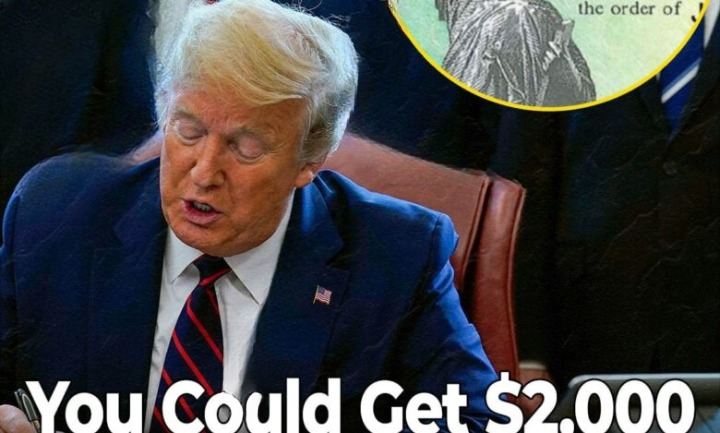The proposal for $2,000 stimulus checks—which former President Donald Trump recently promoted on Truth Social—remains clouded in uncertainty. Trump described the payment as a national “dividend,” promising at least $2,000 per American, with the exception of “high-income” individuals. He also claimed the entire program could be funded with tariff revenue alone. The announcement generated immediate buzz, but economists and policy experts reacted with deep skepticism about the math, the legality, and the logistics behind such a plan.
💰 Trump’s Proposed Stimulus: Big Promise, No Plan
Trump tied the potential checks directly to the supposed success of his tariff strategy, asserting that tariffs are delivering “Trillions of Dollars” to the U.S. government. According to him, this revenue is large enough to reduce the national debt and send cash straight to households.
But at this point, the administration has yet to provide firm details. There are still no official answers regarding:
✔️ Income Requirements
Trump vaguely referenced excluding “high-income” Americans. Treasury Secretary Scott Bessent later suggested a possible cutoff around $100,000 per family, though he emphasized that nothing is finalized.
✔️ Eligibility Rules
It remains unknown whether dependents—such as children—would qualify for separate payments, or how benefits might apply to other household structures.
✔️ Timing
Press Secretary Karoline Leavitt has reiterated that Trump is committed to making the payments happen, but offered no timeline for when, or even if, the checks would be issued.
Most importantly:
Congress has not authorized any such payments.
And Congress has previously refused to support tariff-funded rebates, including when similar proposals appeared in the One Big Beautiful Bill Act.
💸 The Big Problem: Tariff Revenue Doesn’t Cover the Cost
Trump insists tariffs are generating enough revenue to pay for the plan. But economic analysis shows something very different.
📊 The Numbers Don’t Line Up
| Component | Estimate / Figure | Source |
|---|---|---|
| Total tariff revenue collected (as of Sept. 2025) | $195 billion | Treasury Dept. |
| Cost for adults only (with $100k cutoff) | ≈ $300 billion | Tax Foundation |
| Total program cost with dependents | $500–$600 billion | CRFB, Arnold Ventures |
Economist Erica York notes that even limiting payments to adults below the $100,000 threshold would cost $300 billion, already exceeding all tariff revenue collected so far.
If children qualify—which many believe they would—the price tag could surpass half a trillion dollars.
📉 Revenue Reality
Independent economists estimate annual tariff revenue at just $200–$300 billion, far from the “trillions” Trump claims and nowhere near the amount needed to fund a massive stimulus program.
⚖️ Legal Issues Threaten Tariff Funding
Beyond the math problem, the administration’s tariff-based approach faces serious legal roadblocks.
🚨 Supreme Court Case
Trump’s use of the International Emergency Economic Powers Act (IEEPA) to impose widespread tariffs is under Supreme Court scrutiny.
Three lower federal courts have already ruled the administration misused the law.
If the Supreme Court limits the president’s authority, tariff revenue could drop sharply—and with it, the main funding source for the checks.
💵 Tariffs = Taxes on Americans
Economists emphasize that tariffs are paid by U.S. consumers, not foreign countries.
The average American household currently pays $1,600 to $2,600 more a year due to tariff-driven price increases.
This raises a major question:
Does a one-time $2,000 payment actually offset years of higher costs?
🚧 Implementation Hurdles
For Trump’s $2,000 checks to move from idea to reality, several obstacles must be cleared:
🏛️ 1. Congressional Approval
Congress must pass new legislation authorizing payments. No such bill is currently moving forward.
⚖️ 2. Supreme Court Outcome
A ruling restricting Trump’s tariff authority would severely undermine his funding justification.
💵 3. Defining Eligibility
Clear rules must be established:
-
What qualifies as “high income”?
-
Do children count?
-
What about mixed-income households?
💻 4. Payment Infrastructure
The Treasury would need new systems to determine eligibility and distribute funds, whether through direct deposits, checks, or tax adjustments.
Bessent also hinted that the “dividend” might come through multiple tax changes—such as eliminating taxes on tips, overtime pay, and Social Security benefits.
Critics point out these ideas long predate the stimulus promise, meaning the administration may simply be rebranding existing tax policy.
💡 What Americans Should Understand
Right now, the $2,000 stimulus checks are not guaranteed.
❌ No legislation
No authority exists to issue payments.
❌ No finalized criteria
Income eligibility remains undefined.
❌ No timeline
No realistic delivery schedule has been offered.
⚠️ Don’t budget around it
Families should avoid making financial plans based on this hypothetical money. The only confirmed impact of current tariff policy is an increase in consumer prices.
🔍 Stay informed
The safest approach is to rely on official announcements from the Treasury and White House—not viral posts, political statements, or speculation.
